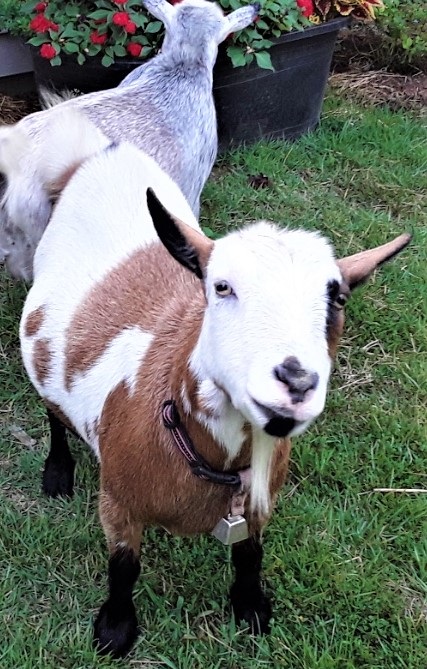DAIRY GOAT BODY CONDITION & Milk Production
Attention to DAIRY GOAT BODY CONDITION is directly related to Reaching Your Dairy Herd Goals

1 BIG FACTOR AFFECTING BODY CONDITION
is NUTRITION:
-
For Example (& this is true of all dairy goats-i.e. Nigerian) -The average Saanen dairy goat in the U.S. produces over 5% of her body weight in milk per day, over a 305-day (10-month) lactation (ADGA Saanen Breed Average for 2016 DHIR Lactations). In addition, she can produce 1-5 kids per year. This level of productivity requires an optimal level of nutrition. High-performing dairy goats do not typically reduce their productivity if the feeding program is inadequate. Rather, they will often maintain a relatively high level of production and their body condition (fat and muscle reserves) will reflect the lack of nutrient intake. Goats are generally classified as intermediate feeders, with the tendency to move toward concentrate selectors and selective grazing. For these reasons, dairy goats cannot maintain body condition on unimproved pasture alone. They require energy and protein supplementation, preferably with concentrates and/or legume hays.
Another Big Factor Affecting Body Condition is Level of Production:
Each year ADGA releases the results of the PERFORMANCE BREEDLEADERS top Ten List.
- All-Time Nigerian Dwarf Milk Production Record Holder SG SUGAR MOON V ZUZANNA 4*M PD1637029 2018 5-02 305 2190-106/4.8-83/3.8 Bred By: Sharon A Peck, Vermont
- All-Time Nigerian Dwarf Butterfat Record Holder SG BETTER WAYZ HARMONY CARABEAR 3*M PD1884511 2020 305 2-11 1350-136/10.4-46/3.4 Bred By: A Better Way LLC, Virginia
It is obvious that these higher producing animals are of higher value to the dairy, but also require greater feed inputs to allow for increased production while maintaining a healthy body condition. We should not assume that just because a doe is a high producer, she will always have a low body condition score. High-producing does may be maintained at healthy BCS levels with good management. Conversely, does that do not reach production levels adequate to justify the level of nutrition being fed will increase in body condition to undesirable levels.
Third Big Factor Affecting Body Condition is
Stage of lactation:
Does will normally be at their lowest body condition score during peak lactation. During a typical lactation curve, an animal’s BCS will show an inverse relationship to the level of production (see figure). Since high-producing animals will lose body condition after kidding and during peak lactation, the feeding program should be adjusted to accommodate the nutritional need. As the days-in-milk increases, milk production will lower, and body condition score will increase. This is desirable for the doe to have body reserves in order to conceive and to carry a number of kids to term. It is not desirable for does to lose body condition during the dry period. They should kid at approximately the same body condition score as at dry-off. At freshening, does should have a relatively high score, in order for them to accommodate loss of condition during peak lactation. Occasionally, managers choose to “milk through” certain highproducing does. This is a management practice that is useful in commercial dairies to increase winter milk production, lessen the stress of kidding and late gestation on the milking does, and decrease the number of kids that have to be fed, managed and sold. Extended lactations can cause does to have higher BCS. This is to be expected and allowances should be made. It may be warranted to keep does separate from other management groups during extended lactations and feed them appropriately.
Stage of gestation: Dairy goats, except for Nigerian Dwarfs, are seasonal breeders. Their typical breeding season is during the fall, and with a 150-day gestational length, they will kid during the spring. Therefore, dairy goats are typically bred when they are at approximately 215 days in milk. This is past peak lactation, so body condition should be ideal for good reproductive performance. Once pregnant, does should be fed to maintain a body condition adequate to support the last months of lactation and the gestation period. Does should not be expected to lose body condition during the dry period.
Age: As dairy goats age, they naturally lose muscle mass and it becomes more difficult for them to maintain body condition as well. When scoring older does and bucks, 7 yrs and older, care must be taken to allow for the reduction in muscle mass but still be able to evaluate the fat cover to determine if an older animal is maintaining an acceptable body condition. Health: Many health factors will directly affect body condition in dairy goats. These include, but are not limited to: parasites, wasting disease, viral or bacterial disease, dental problems (both due to age and/or to malocclusion) and many other chronic conditions. A herd health program should be in place in order to adequately address these factors.
Structural correctness: Correct structure, as outlined in the General Appearance category of the ADGA Scorecard, is necessary for dairy goats to perform at peak and achieve longevity. The American Dairy Goat Association offers a Linear Appraisal program that evaluates dairy goats for both structural and linear traits.
-
(ADGA source of information)



Powered by Boutique Store Builder . Web Design by Avalon Rose Design.

